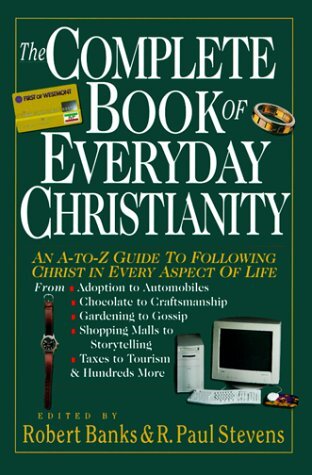Credit
Book / Produced by partner of TOW
“Having lost its value, money may no longer be the root of all evil: credit has taken its place.” (Dalton Camp, Saturday Night Magazine).
Credit is a controversial topic and not just in Christian circles, as the quotation by Dalton Camp illustrates. Nevertheless, credit has become a way of life for most North Americans. In Canada, for instance, there are more VISA cards and MasterCards combined than there are adult Canadians. According to the office of Consumer and Corporate Affairs, credit cards in Canada in 1990 were used for more than a half billion transactions, with interest charges totaling approximately $1 billion.
Attitude Toward Credit
For most people the controversy lies in the abuse of credit, but there are some Christians who feel that credit is inherently wrong. Those who are strongly opposed to the use of personal credit might say that credit cannot be used wisely, but only with differing degrees of foolishness. A study of the typical criticisms of credit use raises many of the theological dimensions of financial life and stewardship.
Credit is inherently wrong. One cannot come to a conclusion about the acceptability of credit without first determining the biblical teaching concerning debt. A brief summary follows (see Debt).
Two kinds of debt are discussed in Scripture: (1) consumer debt, which was usually associated with some kind of personal misfortune such as crop failure, and (2) commercial investments, where a well-to-do Israelite might get involved with a traveling merchant.
With respect to the first kind of indebtedness, God’s people were to be generous in meeting the needs of covenant brothers and sisters (see, for example, Deut. 15:7-10; Matthew 5:42). Israelites with means were to lend whatever was needed to the poor to fend off temporary misfortune and to restore the borrower and his family to financial stability. No interest (usury) was to be charged, and insignificant collateral was to be demanded. Borrowers were obliged under normal circumstances to repay their debts. However, if a debt remained unpaid by the sabbatical year, it was to be forgiven. As was typical with all aspects of the covenant relationship, no one’s poverty was to be taken advantage of by better-off Israelites (Isaiah 5:8).
Commercial debt is hardly mentioned at all. Israel was an agrarian nation and little involved with commercial life. However, such transactions were permitted, and unlike the case of poor covenant brothers and sisters, interest could be charged. Israelites were warned of the dangers of being in debt to another who might well exploit them (Proverbs 22:7).
To summarize, debt was not inherently evil but could be dangerous if the moneylenders were unscrupulous, as they often were. The purpose of consumer debt was not to cater to self-indulgence but rather to ease a person through temporary misfortune and to restore the family unit to stability. Debts were forgivable at legislated intervals (that is, every sabbatical year) to achieve some higher purpose, such as the preservation of the family unit.
Credit is a temptation to materialism. A further criticism of credit is that its easy availability is a temptation to make purchases one cannot afford at this time, or do not really need at all. Businessman and author Jake Barnett puts it very well: “Credit’s main function is to serve materialism” (Barnett, p. 164). Doubtless this is an astute observation. North Americans have realized an increasing standard of living over the past many decades. But with that improving standard has come a greater readiness to take on a larger debt burden. Levels of consumer credit have exploded since the early 1950s. Much of this, of course, is attributable to population growth and inflation. But with these effects removed (in other words, when indebtedness is measured in constant as opposed to current dollars), we are still vastly more prepared than our grandparents were to use, and abuse, credit in larger and larger amounts. In Canada, for instance, per capita increase in the use of credit between 1950 and 1985 was fivefold using constant dollars.
An analysis of consumer bankrupts done by Consumer and Corporate Affairs of Canada in 1982 revealed much disturbing data about the abuse of credit. First, consumer bankrupts tended to be younger than the adult population generally. About 63 percent of these bankrupt individuals were under age 35, a disproportionate number as only 43 percent of Canadians were in this age group. Only 8 percent of consumer bankrupts were age 50 or older. Second, a disproportionate number of personal bankrupts lacked employable skills. Managerial and professional people represented 9.8 percent of the Canadian labor force, but only 2.9 percent of consumer bankrupts. At the other end of the spectrum, unskilled clerical, sales and service personnel and unskilled manual labor constituted 23.4 percent of employees but a whopping 38.8 percent of those who declared personal bankruptcy. Third, and most important for our purposes, the major cause of personal bankruptcy was consumer debt. The median indebtedness of those in the study was $10,865, while median assets were about $400. A breakdown of their creditors is rather interesting. Finance and insurance companies were the major source of credit (74 percent of bankrupts owed these institutions at least one debt), followed by Canadian chartered banks (61 percent), department stores and other retailers (46 percent and 41 percent, respectively) and bank credit cards (30 percent of bankrupts reported money owing on such cards).
A senior employee of an accounting firm specializing in bankruptcies addressed this issue of why younger people who lack good occupational skills and financial prospects are so prepared to burden themselves with consumer debt.
Bankruptcy is very much an attitudinal thing, a commitment to one’s obligations. It takes very little to be technically in a situation of going bankrupt. . . . Many use bankruptcy as a tool to avoid paying debts, especially younger people who believe that they have the right to a certain standard of living without putting out for it. (Sutherland, p. 51)
In summary, we have fueled the rising standard of living with greater and greater amounts of consumer credit. Clearly we are not content to live at the level of previous generations, nor are we prepared to improve our standard strictly through earnings. While income levels have increased in recent decades, debt burden has increased even more. Being able to afford more material things has given many a hunger for an even greater accumulation of goods than can be provided through earnings. Credit as an impetus to materialism is wrong.
To be truly effective, a Christian must be debt free. While this statement sounds plausible, it does ignore the fact that for many, many North Americans the wise use of credit in its various forms has put them on the road to long-term stability and effectiveness in their families, careers, churches and communities. Had I not taken out student loans, I might have avoided a level of indebtedness for some time, but I would have never graduated from either university or seminary. Were it not for my mortgage, I would never have owned a home. Most businesses have relied at least in part on credit to get started or to meet short-term working capital and long-term expansion requirements. The careful use of credit can be a tool toward long-term effectiveness. But the many perils associated with the use of credit must be avoided.
We have established that while credit can be greatly abused, it is not inherently wrong. Used wisely, credit can be a highly effective tool in establishing long-term stability for a family or a business. The issue that remains then is how to use credit properly.
The Right Use of Credit
Incurring debt is a decision to pay for something you bought in the past, rather than saving in order to buy something in the future. Given the cost of credit charges, it usually makes better financial sense to save. However, there are important exceptions, such as purchasing a home or financing an income-producing asset. Therefore, principles concerning how and when credit should be used must be established.
Setting your own credit limits. Merchants are always happy for customers to use credit. Over half of retail sales are made this way. Credit often provides a tie between a merchant and a customer if a person is using the store’s credit card, charge account or installment contract. Consequently, the last place to which you should look for advice in setting your own credit limits is the institution granting the credit. Lenders consider two things when granting any particular level of credit: your total earnings and your other debts. They never ask you what your personal financial objectives are. Unfortunately, many Christians have not taken the time to set such objectives either. This must come first! How is it done?
First, Christians must see their financial resources as gifts from God with which they have been entrusted (see Stewardship). Too many Christians assign this view strictly to the tithe (not that most Christians actually tithe, but that is another story). It is pointless to talk of financial objectives without first accepting that our resources are from God’s hand and that we are accountable to God for their use. This attitude provides a check on materialistic impulses.
Second, calculate net family income, that is, total gross family income minus all the usual deductions plus other costs of earning that income, such as day care, necessary additional clothing, running a car and so on. Then basic necessities of life must be calculated, for example, mortgage or rent payments, utilities, groceries, clothing and so on. As Christians, we should consider a regular schedule of offerings to further the work of God’s kingdom as part of these necessities. All long-term savings needs must be considered as well. These include investments and capital goods, such as a car or a down payment on a home. Noncapital purchases can be anticipated and saved for also, for example, property taxes, Christmas presents and this year’s family vacation.
Finally, ask yourself how much money you can afford to take out of your net family earnings to pay back credit charges that will in no way hinder meeting your financial objectives. This constitutes your personal credit limit.
Deciding what kind of credit to use. This is a complex subject, and the reader is urged to consult the many fine books on the subject of personal finances, including those written from a biblical perspective. Such books are legion. A visit to any decent bookstore will reveal dozens of books on personal finance often tailored to specific situations. What follows are a few brief remarks about some of the most common forms of credit.
The most significant debt that most borrowers will ever experience is a mortgage. Aside from interest rates, features of mortgages vary greatly from lender to lender, for example, how much can be prepaid without an interest penalty. Do not limit your comparison shopping to the interest charged. In addition to the purchase of a home, income-producing assets may rightly be purchased on credit, especially if the interest on the loan is deductible from the taxable income generated.
Items that do not appreciate in value offer fewer advantages as credit purchases. The consumer must weigh the advantages and disadvantages of purchasing via credit, in order to have immediate use of these goods, versus postponing the purchase until sufficient savings are accumulated.
As far as credit cards are concerned, it is best to limit the number you possess because multiple cards only increase the credit limit your lenders have decided is yours and because their availability increases the likelihood of impulse purchasing. In addition, use them only when you can repay the charge within the interest-free period. If you are unable to do this, then you should resort to a cheaper consumer loan from your bank. As with mortgages, shopping around for bank loans is highly recommended. Terms differ greatly.
Conclusion
Credit is often wrong—when it is an impetus to materialism or when it undermines carefully thought through financial objectives. But like many other aspects of material life, credit is amoral. It can be used wisely, or it can be abused. The challenge to the Christian is to see credit in its proper context—as one way of utilizing the resources with which God has entrusted us.
» See also: Credit Card
» See also: Debt
» See also: Investment
» See also: Money
» See also: Stewardship
» See also: Wealth
References and Resources
J. Barnett, Wealth and Wisdom: A Biblical Perspective on Possessions (Colorado Springs: NavPress, 1987); J. R. Sutherland, Going Broke: Bankruptcy, Business Ethics and the Bible (Waterloo, Ont.: Herald, 1991).
—John R. Sutherland






